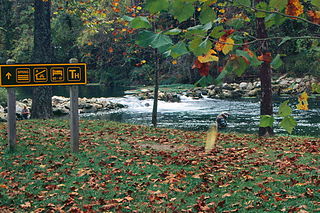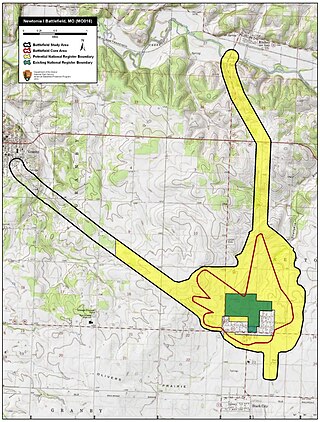
Meramec State Park is a public recreation area located near Sullivan, Missouri, about 60 miles from St. Louis, along the Meramec River. The park has diverse ecosystems such as hardwood forests and glades. There are over 40 caves located throughout the park, the bedrock is dolomite. The most famous is Fisher Cave, located near the campgrounds. The park borders the Meramec Conservation Area.

This is a list of properties and historic districts in Missouri on the National Register of Historic Places. There are NRHP listings in all of Missouri's 114 counties and the one independent city of St. Louis.

Washington State Park is a public recreation area covering 2,147 acres (869 ha) in Washington County in the central eastern part of the state of Missouri. It is located on Highway 21 about 14 miles (23 km) northeast of Potosi or 7 miles (11 km) southwest of DeSoto on the eastern edge of the Ozarks. The state park is noted for its Native American rock carvings and for its finely crafted stonework from the 1930s.

Bennett Spring State Park is a public recreation area located in Bennett Springs, Missouri, twelve miles (19 km) west of Lebanon on Highway 64 in Dallas and Laclede counties. It is centered on the spring that flows into the Niangua River and gives the park its name. The spring averages 100 million gallons of daily flow. The park offers fly fishing, camping, canoeing, hiking, and other activities.

In the law regulating historic districts in the United States, a contributing property or contributing resource is any building, object, or structure which adds to the historical integrity or architectural qualities that make the historic district significant. Government agencies, at the state, national, and local level in the United States, have differing definitions of what constitutes a contributing property but there are common characteristics. Local laws often regulate the changes that can be made to contributing structures within designated historic districts. The first local ordinances dealing with the alteration of buildings within historic districts was enacted in Charleston, South Carolina in 1931.

Fischer Field Stadium is the signature athletic field in Newton, Kansas, and is located in Athletic Park. The stadium is used for athletic events — including high school football and soccer, competitive leagues, and semi-pro football — concerts, Newton High School graduation and a variety of community events and festivals. The stadium is listed on both the Kansas Register and National Register of Historic Places. It can seat up to 5,000 people.

Lake of the Ozarks State Park is a Missouri state park on the Grand Glaize Arm of the Lake of the Ozarks and is the largest state park in the state. This is also the most popular state park in Missouri, with over 2.5 million visitations in 2017.

The Ste. Genevieve National Historical Park, established in 2020, consists of part or the whole of the area of the Ste. Genevieve Historic District, which is a historic district encompassing much of the built environment of Ste. Genevieve, Missouri, United States. The city was in the late 18th century the capital of Spanish Louisiana, and, at its original location a few miles south, capital of French Louisiana as well. A large area of the city, including fields along the Mississippi River, is a National Historic Landmark District designated in 1960, for its historically French architecture and land-use patterns, while a smaller area, encompassing the parts of the city historically important between about 1790 and 1950, was named separately to the National Register of Historic Places in 2002.
Roaring River State Park is a public recreation area covering of 4,294 acres (1,738 ha) eight miles (13 km) south of Cassville in Barry County, Missouri. The state park offers trout fishing on the Roaring River, hiking on seven different trails, and the seasonally open Ozark Chinquapin Nature Center.
The Four Gates Farm, also known as Oak Hill Farm, is a historic home and national historic district located at 13001 Little Blue Rd. in Kansas City, Missouri. The district encompasses two contributing buildings and four contributing structures. The main house was designed by architect Mary Rockwell Hook in 1925, and is a three-story brick and rubble masonry dwelling. It consists of a rectangular main section with flanking wings and features decks, balconies, projecting one-story porches, and an engaged conical roof over a doorway. Other contributing resources are a small stone farmhouse, a free standing conical roofed stone tower, and three stone outbuildings.

The Reading Furnace Historic District is a national historic district that is located in Warwick Township and East Nantmeal Township, Chester County, Pennsylvania.

The Knoxville WPA Athletic Field Historic District is a nationally recognized historic district located in Knoxville, Iowa, United States. It was listed on the National Register of Historic Places in 2007. At the time of its nomination the district consisted of 14 resources, including three contributing buildings, seven contributing structures, one contributing site, two noncontributing buildings, and one noncontributing structure. The oldest structure in the district is the city-owned water tower that was completed in 1922 on what was the city reservoir. Two Works Progress Administration (WPA) projects were added in the 1930s.
The State Quarry, Iowa Men's Reformatory is a nationally recognized historic district located northwest of Anamosa, Iowa, United States. It was listed on the National Register of Historic Places in 1992. At the time of its nomination the district consisted of five resources, including three contributing buildings, one contributing site, and one contributing structure. This was the second quarry operated by the Anamosa prison. The first was opened in 1872 near Stone City in 1872, and it was exhausted by 1877. They acquired two 40-acre (16 ha) parcels here in 1878 and another the following year. The stone quarried and dressed on site by the prisoners was used to build the prison and sold to other government agencies in the state for their building purposes. None of the stone was placed on the open market. The Chicago and North Western Railroad provided a connection to transport the materials. The last of the usable building stone was quarried in 1915, when they shifted to crushed gravel. The quarry remained in operation until 1943.

Moreau Park Historic District is a national historic district located near Jefferson City, Cole County, Missouri. It encompasses seven contributing buildings, one contributing site, and five contributing structures associated with a former resort along the Moreau River near Jefferson City. The district developed between about 1914 and 1950, and includes some historic landscaping features, the native stone Dallmeyer House, Moreau Lodge (1914), one remaining guest cabin, two stone outbuildings, a privy, barn, and concession stand.

The First Battle of Newtonia Historic District, near Newtonia, Missouri, is a National Register of Historic Places (NRHP) site that preserves the location of the First Battle of Newtonia, an 1862 battle during the American Civil War. The battle saw Confederate troops under Colonels Douglas H. Cooper and Joseph O. Shelby defeat a Union force commanded by Brigadier General Frederick Salomon. The historic district contains some Civil War-period structures, as well as the Mathew H. Ritchey House, which is listed separately on the NRHP.
Samuel T. and Mary B. Parnell House, also known as Mt. Branson Lodge, is a historic home located near Branson, Taney County, Missouri. It was built about 1912 and is a two-story, American Craftsman-style dwelling constructed of irregular rubble courses of native stone. The façade features a partial-width, two-story porch supported by massive, battered stone piers. Also located on the property is a contributing one-story, rock and wood-frame garage.
John Ross House, also known as Old Matt's Cabin, is a historic home located at the Shepherd of the Hills farm near Branson, Taney County, Missouri. The original section was built in the mid-1880s or mid-1890s, as a single cell log structure. It was subsequently enlarged with frame additions through 1910. It features a stone exterior end chimney.
Sammy Lane Resort Historic District was a national historic district located at Branson, Taney County, Missouri. The district encompassed four contributing buildings and two contributing structures built between 1925 and 1943 as part of a resort. They were four log and native rock resort cottages, an elaborate native rock landscape construction and a well house. The buildings and structures were excellent vernacular examples expressive of the Bungalow / American Craftsman aesthetic. The resort has been demolished and replaced with The Branson Landing.

The Camp Harlan-Camp McKean Historic District, also known as the Hugh B. and Mary H. Swan Farmstead and the Springdale Stock Farm, is a nationally recognized historic district located northwest of Mount Pleasant, Iowa, United States. It was listed on the National Register of Historic Places in 2013. At the time of its nomination it consisted of eight resources, which includes two contributing buildings, one contributing site, one contributing object and four non-contributing buildings.
Fred Maytag Park is a public park located in Newton, Iowa, United States. It was listed as a historic district on the National Register of Historic Places in 2010. At the time of its nomination it contained 39 resources, which included seven contributing buildings, nine contributing sites, eight contributing structures, four contributing objects, four non-contributing buildings, two non-contributing sites, three non-contributing structures, and two non-contributing objects. The park was a gift from F.L. Maytag, founder of the Maytag Company, to the people of Newton. It is significant as an example of a privately funded public park during the Great Depression. The 40-acre (16 ha) partial of land was acquired by Maytag in 1935. It had previously served as the fairgrounds owned by the Jasper County Agricultural Society. He made an agreement with the city council that the park would be privately owned and operated, but open for public use. The city was required to provide water and electricity. It remained a privately owned park until 1977 when it was conveyed to the city.
















